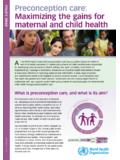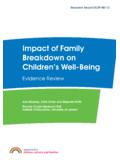Transcription of Developing - American Psychological Association (APA)
1 DevelopingAMERICAN Psychological ASSOCIATIONA dolescentsDevelopingAdolescentsA Reference for ProfessionalsDevelopment of this document was supported by Cooperative Agreement No. U93MC00105 from the maternal and Child Health Bureau, Health Resources and Services Administration, Department of Health and Human 2002 by the American Psychological Association . All rights iiPreface 1 Professional Contexts and Boundaries 1 Introduction 3 Recognizing Diversity 4 Organization of Developing Adolescents 5 Adolescent Physical Development 7 Puberty and Sexual Development 7 Early or Late Sexual Development 8 Physical Appearance and Body Image 8 Physical Activity and Weight 8 Disordered Eating 9 Adolescent Cognitive Development 11 Moral Development 13 Learning Disabilities 13 Adolescent Emotional Development 15 Developing a Sense of Identity 15 Raising Self-Esteem 16 Emotional Intelligence 17 Group Differences in Emotional Development 18 Gender Differences 18 Ethnic Diversity 18
2 Gay, Lesbian, and Bisexual Youth 19 Adolescent Social Development 21 Peer Relationships 21 Dating and Sexual Behavior 22 Family Relationships 23 School 24 Work 25 Community 26 The Influence of Neighborhood Characteristics 26 Faith Institutions 27 The Media 27 Adolescent Behavioral Development 29 Reasons for Adolescent Risk Taking 30 When Risk-Taking Behavior Becomes Problem Behavior 31 Alcohol and Drug Abuse 31 Pregnancy and Sexually Transmitted Diseases 32 School Failure and Dropping Out 32 Delinquency, Crime, and Violence 32 Protective Factors and Resilience 33 Conclusion 34 References 35 DevelopingAdolescents:A Reference for ProfessionalsAMERICANPSYCHOLOGICALASSOCI ATION750 First Street, NEWashington, DC 20002 4242 Among the individuals who helped along the way were dedicated federal officials from the maternal and Child HealthBureau: Trina Anglin, MD, Chief of the Office of AdolescentHealth; Audrey Yowell, PhD, Project Officer; Isadora Hare,MSW, formerly an APA colleague and the initiator of the adolescent development project for this Association .
3 And thelate Juanita Evans, MSW, who had the vision to create thePIPPAH initiative during her tenure as Chief of the Office ofAdolescent also appreciate the many individuals who shared theirexpertise with us and provided input throughout this thanks go to Margaret Schlegel, a science writer whodeveloped the initial organization and an early draft of the offer Developing Adolescentsas an information resourcefor many professionals, including psychologists, as they dealwith adolescents in varied roles as health professionals,school teachers and administrators, social service staff, juve-nile justice officials, and H.
4 Gentry, PhDDirector, Public Interest InitiativesMary CampbellChildren, Youth, & Families OfficerAcknowledgmentsMany kinds of expertise are needed to fully address healthissues of adolescents in American society, and many kinds ofexpertise went into the development of this are especially grateful to Andrea Solarz, PhD, Manager ofthe APA Healthy Adolescents Project. Her leadership and substantive expertise are reflected both in the way she hasguided the completion of the overall project and in her excellent work on this publication. In the development of thisdocument, she refined the basic conceptual frame for themanuscript and maintained the highest standards for the sci-entific integrity of the material.
5 She reviewed literature anddirected the manuscript review process, integrating recentresearch findings as well as experts suggestions and com-ments into the text. Her meticulous editing included detailedattention to the nuances of translating specialized scientificreports into material that is accessible to a wide range of APA also appreciates the professional support and practical assistance offered by colleagues in the Partners inProgram Planning for Adolescent Health (PIPPAH), a collaborative project supported by the Office of AdolescentHealth of the maternal and Child Health Bureau. PIPPAH partners reviewed drafts of this document and offered substantive comments on its content.
6 The reviewing organizations include: American Academy of Pediatric DentistryAmerican Bar AssociationAmerican Dietetic AssociationAmerican Medical AssociationAmerican Nurses AssociationAmerican School Health AssociationNational Association of Social WorkersOffice on Adolescent HealthViews expressed in this document have not been approved by the governingor policy-setting bodies of any of the PIPPAH partners and should not be con-strued as representing policy of any specific AdolescentsDeveloping AdolescentsPrefaceThe American Psychological Association (APA) is pleasedto offer Developing Adolescents: A Reference forProfessionalsfor the many professionals who, becausethey work with adolescents, need substantive knowledgeabout the trajectory of youngsters lives from late elementary school ages through high school Adolescentsis a response to requests bynumerous professionals in various fields for help inunderstanding and working with adolescents.
7 In particular, the organizations involved in the Partnershipin Program Planning for Adolescent Health (PIPPAH),who work together to promote adolescent health activities nationally, expressed interest in having a document to help professionals physicians, attorneys,nurses, school-based health providers, social workers,dentists, and dieticians, to name a few understand crucial aspects of normal adolescent development andrelate more effectively to the adolescents with whomthey an impressive array of literature on adolescentdevelopment exists, much of this information is published in specialized journals not easily accessible toprofessionals in other fields.
8 Developing Adolescentspresents, in an accessible way, research findings on thecognitive, physical, social, emotional, and behavioralaspects of normal adolescent development to helpguide professionals working with adolescents in manydifferent contexts. There is currently no standard definition of adolescent. Although often captured as an age range, chronologicalage is just one way of defining adolescence. Adolescencecan also be defined in numerous other ways, consideringsuch factors as physical, social, and cognitive develop-ment as well as age. For example, another definition ofadolescence might be the period of time from the onsetof puberty until an individual achieves economic inde-pendence.
9 What is most important is to consider carefully the needs and capabilities of each the purposes of this document, adolescents are generally defined as youth ages 10 to this definition, there were an estimated million adolescents in the United States in 2000 ( CensusBureau, 2001a).Professional Contexts and BoundariesA first step in working with youth and often by extension their families and the social systems withwhich they engage, such as schools is to understandone s role and professional boundaries. School socialworkers, for example, are often called on to provideguidance to families or to conduct parenting groups andso may be particularly interested in learning what Psychological research has discovered about effectiveparenting strategies with adolescents.
10 Attorneys, on the other hand, may have little need forsuch information and may be stepping outside of theboundaries of their professional role if they make suggestions to parents about such things as parentingstyles,3even if they are asked to provide advice on parenting. Physicians, who play an important role ininterpreting normal physical development to teens andparents, are also often the first contact for consultationabout behavioral issues such as substance abuse. Thus, sections of this publication that refer to parentingwill be more or less relevant depending on one s professional role. The same is true with regard to othertopics they will be more or less relevant depending onthe reader s professional context and statutes govern some behavior of and mental health professionals and teachers,for example, have specific legal obligations to act upon ifthey suspect that a young person has been of confidentiality are pertinent to all professionals and are generally addressed in law as well 1 PIPPAH is funded by the Office of Adolescent Health, a unitof the maternal and Child Health Bureau, HealthResources and Services Administration, Department ofHealth and Human Services.














